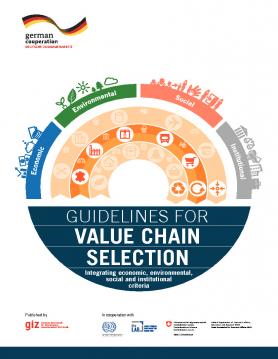You are here
Guidelines For Value Chain Selection - integrating economic, environmental, social and institutional criteria
An initial step in value chain development is to assess various potential sectors or value chains to determine in which the project might have the greatest impact through interventions according to specific development goals and project mandates. These guidelines are meant for use during the initial (design and formulation) phase of projects in order to compare and prioritize possible value chains for promotion. The Guidelines offer a holistic and structured approach to value chain selection. They combine four different dimensions of value chains/sustainable development: (1) economic, (2) environmental, (3) social and (4) institutional. Since the four dimensions are interconnected, overlooking any one of them during value chain selection will affect the next phase of value chain analysis and development. Because currently no comprehensive or systematic approach or methodology exists that combines these four dimensions, these guidelines have been developed to fill the gap.
The guidelines provides users with the 8 steps process for value chain assessment and selection: (1) Starting point: scope and mandate of the programme, (2) Screening and shortlisting of promising value chains, (3) development of matrix with dimensions and criteria, optional weighing and scoring, (4) desk study, (5) instruction of field staff and local consultants, (6) field investigation, (7) workshop for validation and recommendations and lastly (8) findings review, analysis and recommendation. The guidelines also include clear criteria and a set of tools to be used in the value chain selection process.
Copyright © 2020 Grow Asia Terms of UsePrivacy PolicyContact Us

